Rainbow crosswalks were installed in the Church-Wellesley Village in honour of 2014 WorldPride. The vibrantly coloured crosswalks can be found at the intersections at Church and Alexander, and Church and Isabella. Pride Toronto created the rainbow crosswalks to welcome visitors to WorldPride in 2014 and remained as a permanent legacy of the event for years to come. Rainbows, of course, are an international symbol of queer pride.
Downtown Yonge Artwalk
Artwalks
Colour
Between buildings and asphalt, the streets of Toronto, on a grey day, can be a little bleak. This is why colour in public artwork is such a compelling creative factor! Here is a walk that will take you on a stroll that will colour your day!
Rainbow Crosswalks

- Paint
- 2014
- Church and Carlton area (Church & Wood), Toronto
About the artwork
About the artist
N/A
Fun facts
- Originally devised by artist Gilbert Baker, the rainbow flag design has undergone several revisions since its debut in 1978, first to remove colours then restore them based on availability of fabrics. Baker's first rainbow flag had eight colours, though the most common variant consists of six stripes: red, orange, yellow, green, blue, and violet.
Engagement questions
- Does this work impact how you feel about the space around it?
- In what way can art be a means to communicate social movements and inclusive values?
To Serve and Protect
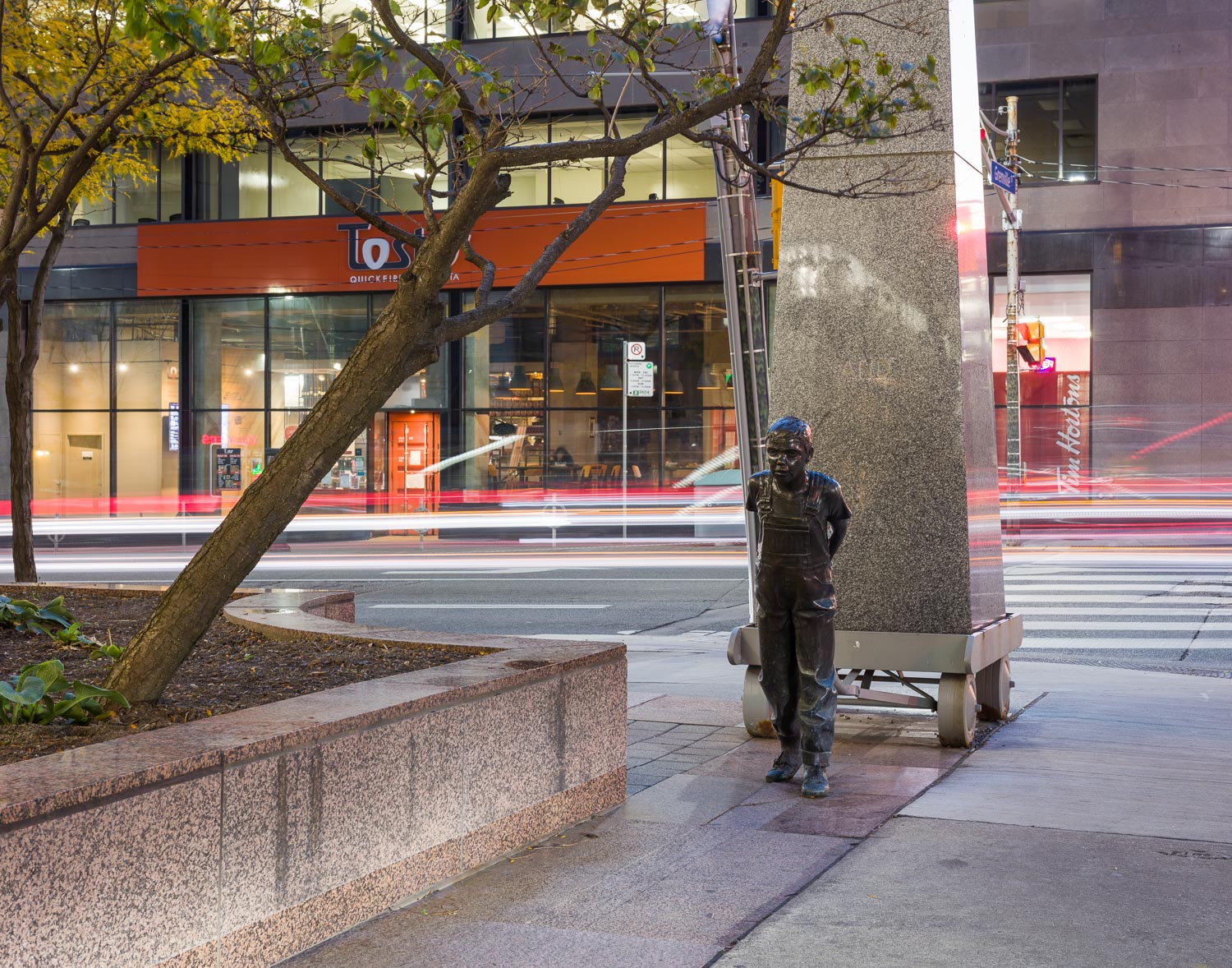
- Bronze, masonry, painted steel
- 1988
- 40 College Street, Toronto
About the artwork
This sculpture is an allegorical trinity of elements in three distinct sites of the Police Headquarters building in downtown Toronto. The three elements may stand alone but together they form a unified narrative. There are three life-size realistically rendered figures performing three actions.
In the central square of the building is a policewoman, police radio in one hand, a trowel in the other constructed a stone base. At the northwest corner of the building is the rendering of a child pulling an oversized child’s wagon. An obelisk sits on the wagon. The wagon is constructed of metal with a two-inch-thick base plate on which the obelisk floats.
At a side entrance, walking into the building is a male figure carrying a primitive support on which are balanced two books and two stone blocks on his shoulders.
About the artist
Eldon Garnet is a multidisciplinary artist and writer based in Toronto. Surveys of his sculptures and photographic work have been held at the National Gallery of Canada, the Museum of Contemporary Canadian Art and the Amsterdam Center of Photography. He is represented by the Christopher Cutts Gallery in Toronto and Torch Gallery in Amsterdam. Garnet is also a professor at the Ontario College of Art and Design University.
Constructing an unsettling ambiguity by using whatever means of expression Garnet deems suitable is probably the only connecting thread in his works. Instead of defining himself as an artist with a central medium, he tries to create an allegory of words, images, sound and time.
His projects often take on the qualities of a contemporary gesamtkunstwerk (the German term “Gesamtkunstwerk”, roughly translates as a “total work of art” and describes an artwork, design, or creative process where different art forms are combined to create a single cohesive whole) that surpasses both the obvious narrative and the postmodern ironic.
He uses tools like humour, erotic triggers and commonplace semiotic patterns, but never lets them reach their perceived conclusion. The effect is best described as a recognition of the joke but never getting to the punchline, or feeling disgusted or aroused but never quite understanding why.
Fun facts
- The obelisk is polished Canadian granite 21 feet high, 3 foot square at the base.
Engagement questions
- How does this work make you feel?
- How do you engage with the subject of the work?
Untitled
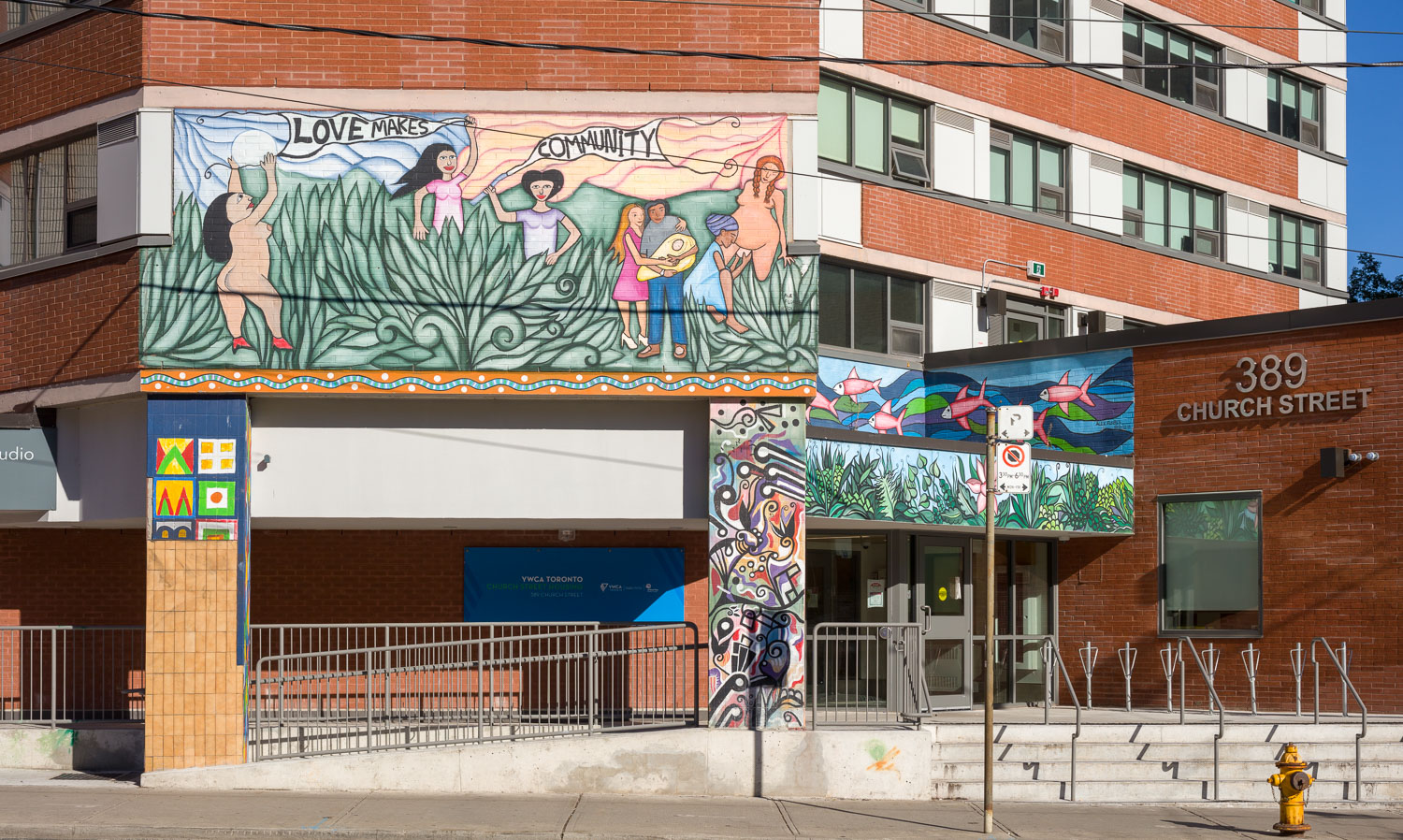
- Latex Paint
- 2013
- 389 Church Street, Toronto
About the artwork
This bright and colourful mural celebrates women throughout the world. Part of The Church Street Mural Project, the mural project sprang out of a desire to spruce up the neighbourhood and leave a lasting legacy for WorldPride festivities.
Project curator Syrus Marcus Ware says there was a lot of interest from artists to get involved with the project, which allowed the selection committee to choose projects that reflected the community.
About the artist
Alex Flores is the founder and Artistic Director of Las Perlas Del Mar Productions Inc. Flores has extensive mural and multimedia production experience, including ten years of experience as an independent filmmaker, using documentary video production and web design. He has been a visual artist for 18 years.
Artist Statement:
“When I create a painting, my energy becomes happy and positive. Through meditation, I dream I am in forests full of trees, with people and animals in different colours, the shapes become houses where all human beings live in harmony, surrounded by the beauty of the earth.
My paintings are like big urban cities or the jungle in spring, or like people gathering on a cold winter night. I paint my hometown in Mexico City mixing ideas with my home in Toronto.
My mind flies away onto the white canvas with ideas of colourful buildings, faces, trees, pets and harmony around all humans.
I want to show my vision about living in a safe world, where justice and peace and love come together.
The different shapes and structures in my paintings may seem surrealistic; this is an aspect of my technique that I love. I like people to think about what they see in my artwork.”
Fun facts
- As well as being a muralist and artist, Alex Flores has extensive experiences in multimedia production, even creating her personal online video platform to promote culture, politics and reflecting on the Latin community in Toronto and Canada.
Engagement questions
- Do you think Toronto needs more colourful artworks for its public realm?
- Why is this mural important for the community? And for women around the world?
Imagine Together
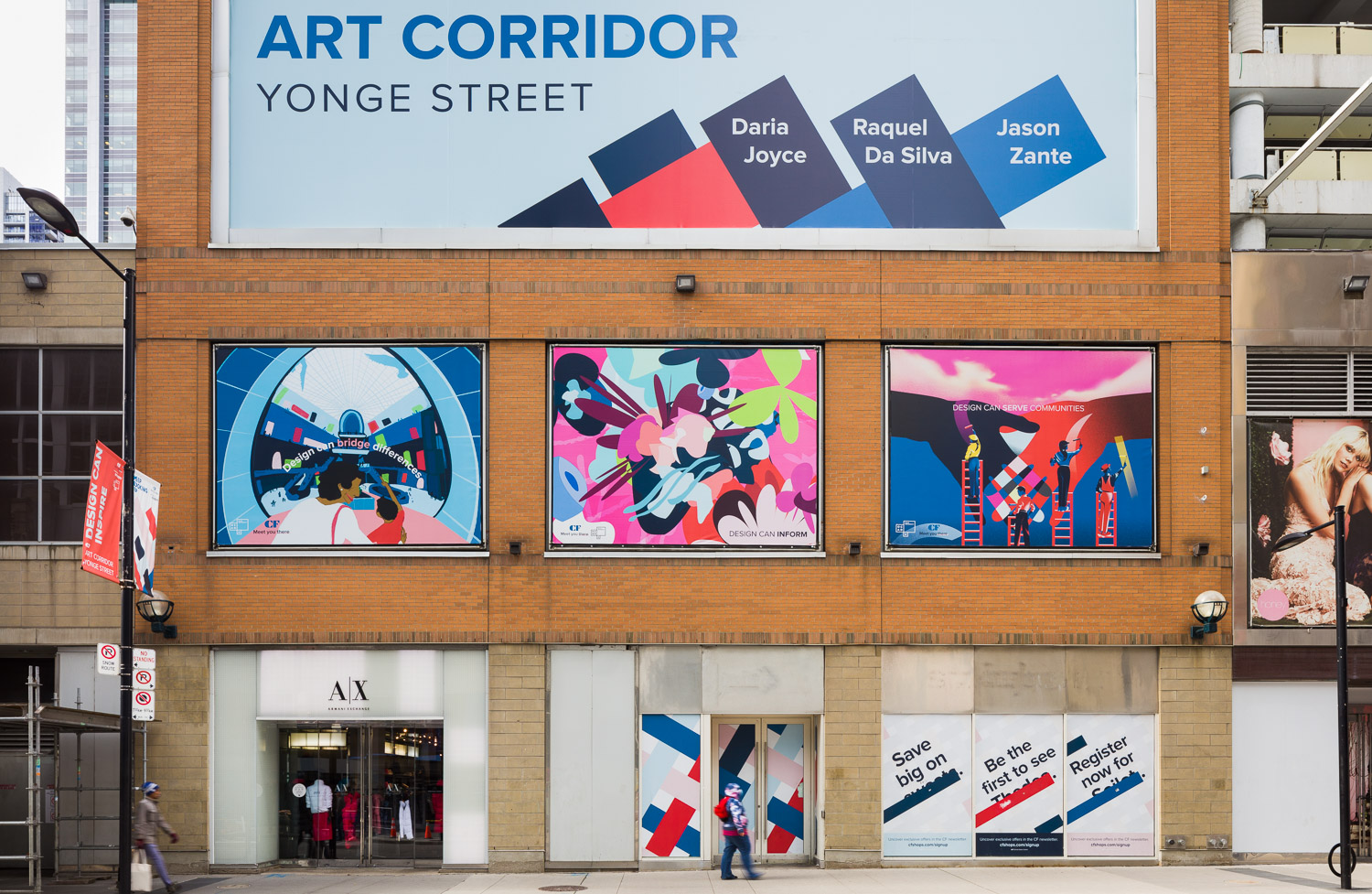
- Spray Paint
- 2021
- 220 Yonge Street, Toronto
About the artwork
Many of us missed human connection during the lockdown. All the time of social distancing made us realize that we truly need each other in many ways. Community is at the heart of what keeps us together. Where we live, work and play. With that in mind, Cadillac Fairview (CF) in collaboration with OCAD University has unveiled an inspiring new space for local creatives — the CF Toronto Eaton Centre Art Corridor.
Visitors of the popular local and tourist destination can find a portion of Yonge Street from Dundas to Queen transformed into a beautiful outdoor digital gallery located above the iconic shopping centre. The exhibition titled Imagine Together features original works by emerging OCAD University artists in an 18-month long exhibition. A total of nine inspiring works will be featured in the massive exhibit in alignment with CF’s overall commitment of Transforming Communities for a Vibrant Tomorrow.
The original call for submission asked OCAD University’s Faculty of Design graduates to consider how art can bring people together and build community. Each artist was asked to reflect on their personal experiences about what it means to be inclusive, together and socially connected. Within their designs the artists were asked to consider physical, emotional and sensory elements to nurture community and empower individuals.
Toronto-based artists Raquel Da Silva, Jason Zante, and Daria Joyce will be featured during this incredible exhibition.
About the artist
Working primarily in paint and sculpture, artist Raquel Da Silva focuses on creating abstract environments. Currently her work explores how two and three-dimensional forms and shapes can work together to create an environment. Her art in this collaboration celebrates the vibrant culture of our city. She reflects on that energy to inform, inspire, and regenerate. Da Silva recently completed a one-year residency at the Museum of Contemporary Art in Toronto.
Filipino-Canadian multidisciplinary artist, Jason Zante, has already gained a huge fanbase in the art scene. He’s known for his use of vibrant colours, bold contrasts and ethereal landscapes in his art. If his style looks familiar you may have recently passed by his larger than life mural titled The Riviera located at the Four Seasons Hotel Toronto. His work has also been featured in Architectural Digest.
Illustrator Daria Joyce‘s playful and vibrant style reflects the power of connection at one of North America’s largest shopping destinations located right here in the heart of our city. Her work depicts the inspiring environment bringing people together into the communal experience beyond retail activity.
Fun facts
- This is the first time these billboards are being used for community artwork rather than advertising.
Engagement questions
- Do you think the public realm should be less about advertising campaigns and more about public art?
- Do you believe in the power of art as a useful tool to reach out to communities?
History of Music Mural: South
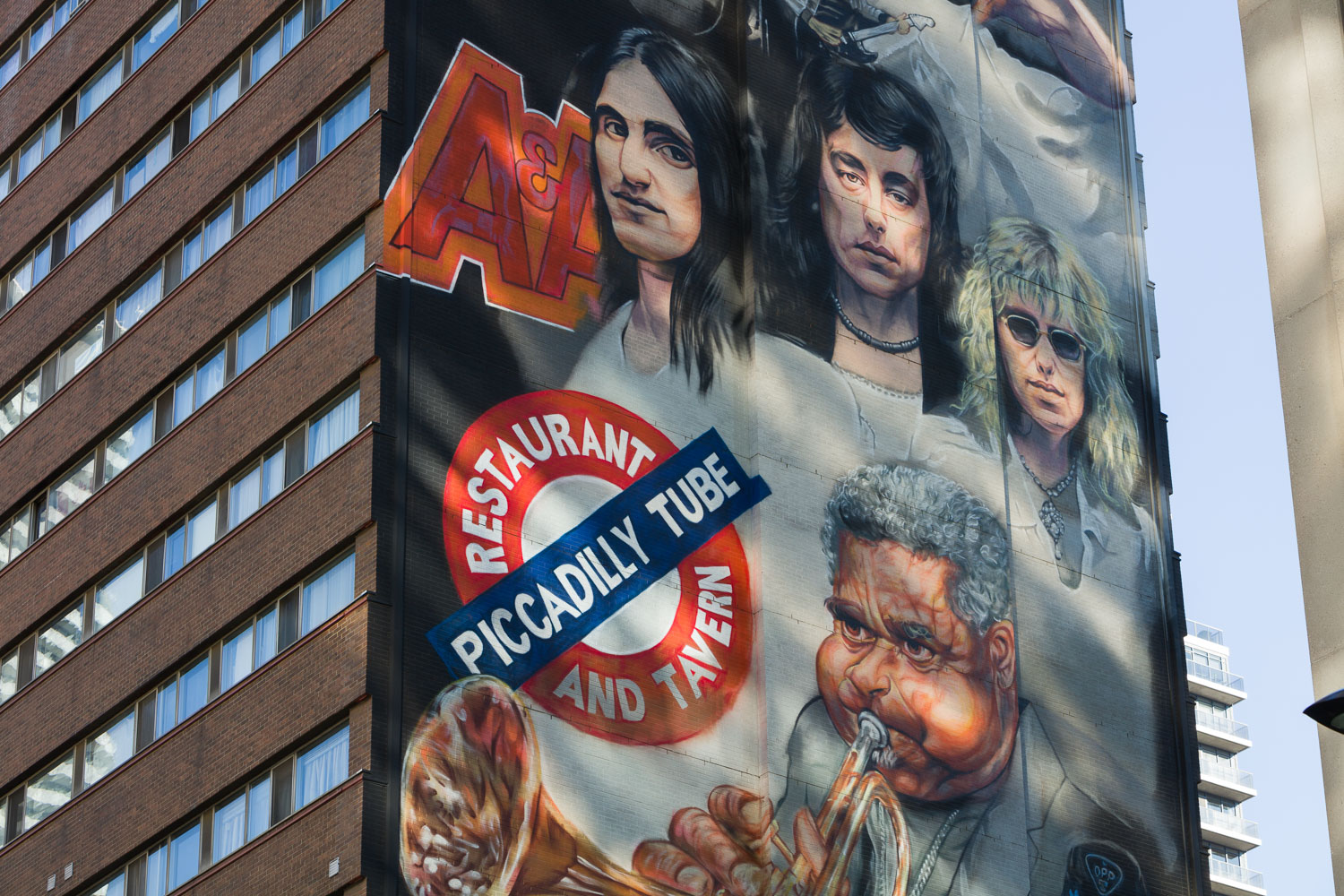
- Spray Painting
- 2017
- 423 Yonge Street, Toronto
About the artwork
This is a major endeavour for Downtown Yonge BIA to pay homage to the rich history of music on Yonge Street. This reiterates our music strategy and DYBIA’s commitment to arts & culture as an economic driver.
Designed by Hayles (aka DJ Sawtay), the mural on the Toronto Community Housing building features the likenesses of Rush, Goddo, the Band, David Clayton Thomas, Lonnie Johnson, Salome Bey, Carole Pope, Cathy Young, Jay Douglas, Kim Mitchell, Mandala, and John and Lee and the Checkmates. Commissioned by the Downtown Yonge BIA, it’ll also include historic bygone music spaces like Gasworks, A&A Records, Piccadilly Tube, Steele Tavern and the Brown Derby Tavern.
“This mural ties into the importance of Yonge Street and all the artists and venues that have played this iconic street,” Downtown Yonge BIA executive director Mark Garner tells NOW. “Yonge Street contributed significantly to the Canadian music scene, but also to the North American scene.”
Hayles also painted the mural on the building’s north side. Completed in 2017, it includes the images of Ronnie Hawkins, Glenn Gould, Oscar Peterson, Jackie Shane, Shirley Matthews and Gordon Lightfoot, among others, as well as venues Le Coq d’Or and Massey Hall, and the Sam the Record Man sign.
About the artist
At the tender age of nine, Toronto-based illustrator Adrian Hayles discovered the expressive nature of the visual arts. With his continued artistic development, illustration became his deepest passion. His desire to learn and absorb from his surroundings led him on a personal creative journey. As a graduate of the Graphic Design program at Humber College with over ten years of working experience behind him, Hayles has established his place in Toronto’s modern art community.
His style is provocative, inspiring and defies categorization. Blurring the lines between graffiti and ultra-realism, his voice and vision is instantly identifiable. His works include countless portraits and illustrations for various magazines and collaborations with the City of Toronto to develop murals for vacant community spaces. In the past, he has painted complete buildings and city blocks, designed award-winning video games and animated television shows.
Fun facts
- The initiative came along with a new engagement process to deter graffiti and embellish the neighbourhood. When city officials asked the people of Yonge what they would like to see in the area, people mentioned the need for more public art. During the co-creation sessions with the cities, two main themes were suggested, the music scene of Yonge or the reflection of nature. In the end, the power of music won.
Engagement questions
- Why is music so important for the Yonge community?
- How do you think people will interact with the mural and relate to the history of the site?
History of Music Mural: North
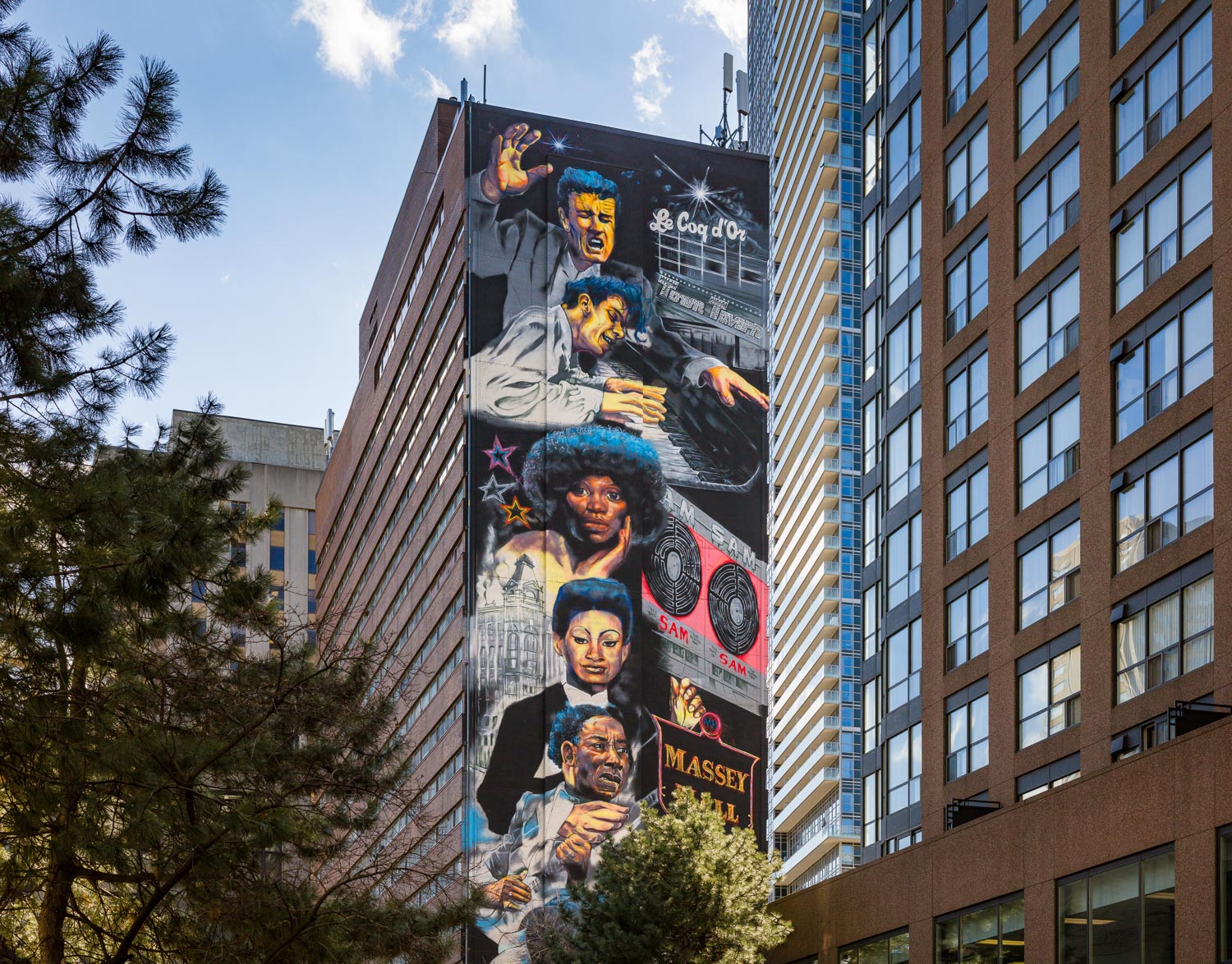
- Spray Painting
- 2017
- 423 Yonge Street, Toronto
About the artwork
This is a major endeavour for Downtown Yonge BIA to pay homage to the rich history of music on Yonge Street. This reiterates our music strategy and DYBIA’s commitment to arts & culture as an economic driver.
Having achieved eye-popping success with its first giant music mural, the Downtown Yonge BIA commissioned a second 22-storey tribute to Toronto’s musical heritage. The mural covers the entire south face of the Toronto Community Housing building at 423 Yonge Street, complementing the existing mural on the north wall.
“These murals are dazzling sights to celebrate amazing sounds,” says Downtown Yonge BIA Chief Operating Officer and Executive Director Mark Garner. “They are a stunning visual reminder of the long, vibrant history of music in Downtown Yonge, which continues today.”
The first mural featured images from the 1950s and ‘60s. The new addition also celebrates music legends from that era, augmented by 1970s and ‘80s stars. Luminaries gracing the second mural include The Band, David Clayton-Thomas, Rush, GODDO, Carole Pope, Kim Mitchell, Salome Bey and Lonnie Johnson. Once again, marquees from landmark Toronto music venues will fill out the scene, including the Brown Derby Tavern, Gasworks, Piccadilly Tube and A&A Records.
Hayles, who created the first mural, spent two to three months completing the new 70-metre-tall artwork. The new mural is part of the Downtown Yonge BIA’s Music Strategy, an ambitious, multi-pronged plan to re-establish the area as a ‘Music Mecca.’
The mural is supported by StreetARToronto (StART), an initiative of the City of Toronto, Transportation Services Division, and a central feature of Council’s Graffiti Management Plan. The plan encompasses a proactive approach to eliminating graffiti vandalism, while adding vibrancy and visual interest to city streets.
About the artist
At the tender age of nine, Toronto-based illustrator Adrian Hayles discovered the expressive nature of the visual arts. With his continued artistic development, illustration became his deepest passion and talent. His desire to learn and absorb from his surroundings led him on a personal creative journey. As a graduate of the Graphic Design program at Humber College with over 10 years of working experience behind him, Adrian has established his place in Toronto’s modern art community.
His style is provocative, inspiring and defies categorization. Blurring the lines between graffiti and ultra realism, Adrian’s voice and vision is instantly identifiable. His works include countless portraits and illustrations for various magazines and collaborations with the City of Toronto to develop murals for vacant community spaces. In the past Adrian has painted complete buildings and city blocks, designed award winning video games and animated television shows.
Fun facts
- The initiative came along with a new engagement process to deter graffiti and embellish the neighbourhood. When city officials asked the people of Yonge what they would like to see in the area, people mentioned the need for more public art. During the co-creation sessions with the cities two main themes were suggested, the music scene of Yonge or the reflection of nature. In the end, the power of music has won.
Engagement questions
- Why is music so important for the Yonge community?
- How do you think people will interact with the mural and relate to the history of the site?
The History of Theatre on Yonge Street
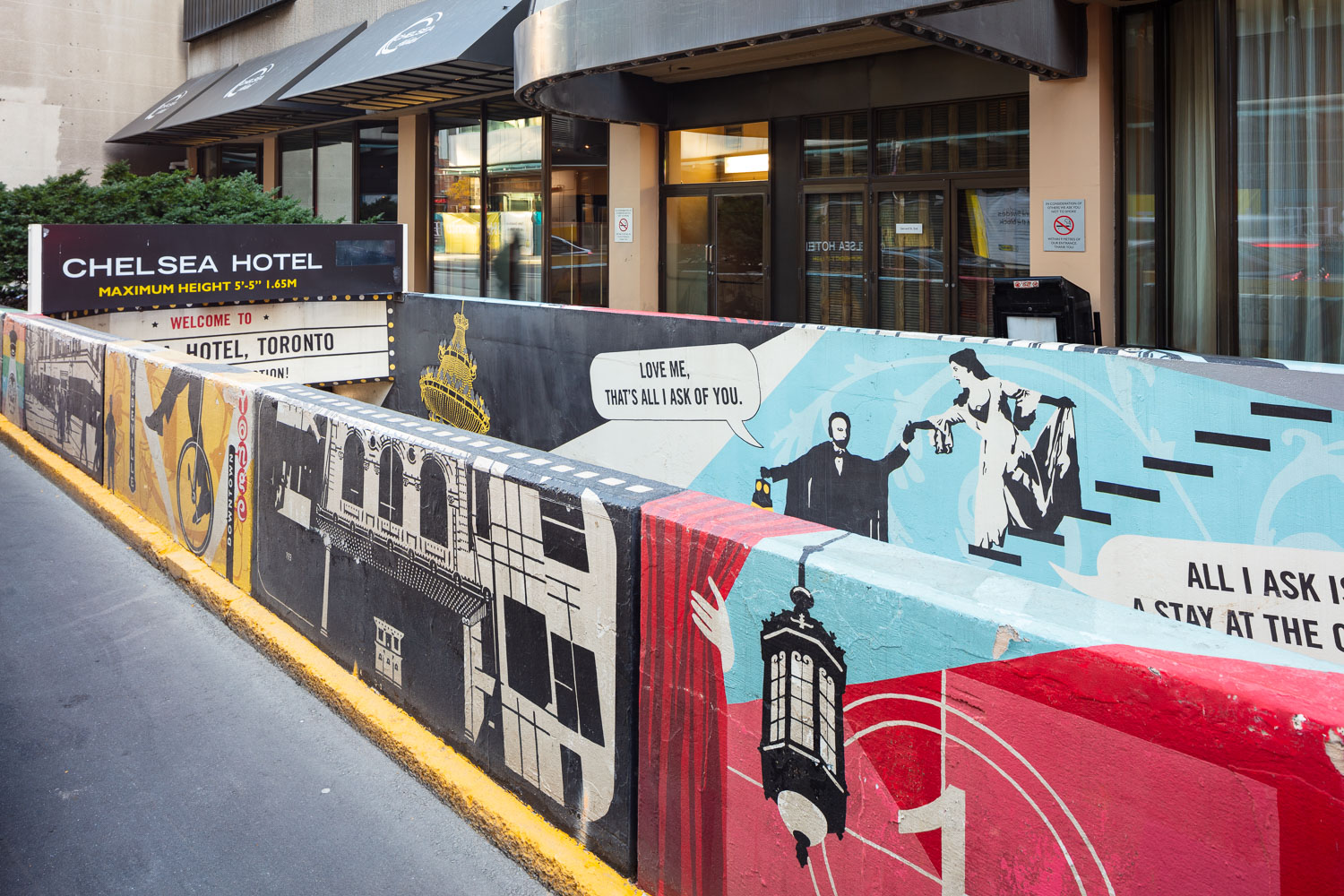
- Spray Painting
- 2018
- 33 Gerrard Street West, Toronto
About the artwork
In collaboration with the Chelsea Hotel and Downtown Yonge BIA, this mural showcases Yonge Street’s theatre scene over the past century. The wall stretches 145-feet long with images of theatres, props and actors depicted in horizontal panels to look like a film strip. Life-size patrons and children line the pedestrian sidewalk, while vintage cars are painted on the street side.
Four panels include realistic facades of four different theatres that were painted in black and white to give a timeless feel and add to the historical theme. Colourful beams of light tie the entire mural together as they illuminate from old projectors, stage lights and headlights. The inside of the ramp includes the familiar underground scene from the Phantom of the Opera. A painted marquee welcomes guests as though they’re entering a theatre. “Park. Check-in. Action!”
About the artist
Pam Lostracco is recognized as an award-winning graphic designer and artist. While studying at OCAD, she completed an exchange in Scotland, won a group competition and earned two scholarships—including her name on a plaque at The Arts and Letters Club.
Pam has worked for several Toronto design studios, including Dinnick & Howells and Viva Dolan. While working with the best art directors, she produced high-end books and identities for clients including Butterfield & Robinson, Curious Papers and Ace Bakery. These projects earned awards from the Advertising & Design Club of Canada, Applied Arts, and Communication Arts. Her illustrations have also been printed in books for Jump Math and Fisher Price, and she continues to design books and logos.
A year-long travel endeavour, started a new artistic path of making mixed-media artwork. Her drawings and photographs were layered into a unique style that has been exhibited at the McMichael, Toronto Outdoor Art Exhibition and Toronto Pearson International Airport. She has collaborated with public art projects, including a bench design for Liberty Village, photographs presented in TTC stations for the Contact Photography Festival, and a traffic lightbox for the city’s Outside the Box program. Pam’s artwork and products have been purchased by the Four Seasons Hotel, Craft Ontario and The Textile Museum of Canada.
Now, Pam is designing and painting walls for homes, condos, shops and resorts around Canada. Her murals have been featured on Apartment Therapy and Pinterest. Pam’s goals are working towards helping to improve communities and health care facilities around the world. She continues to draw nature and explore places, while at the same time, create beautiful and uplifting spaces.
Fun facts
- This mural showcases the history of theatre on Yonge Street and reminisces on the hotel’s involvement as the go-to entertainment hotel, bringing to life theatre within the street.
Engagement questions
- How can public art bring to life the old hidden story of an entire neighbourhood?
- Can public art help bridge the gap between diverse forms of art for the community?
Curtain, NXNE Festival
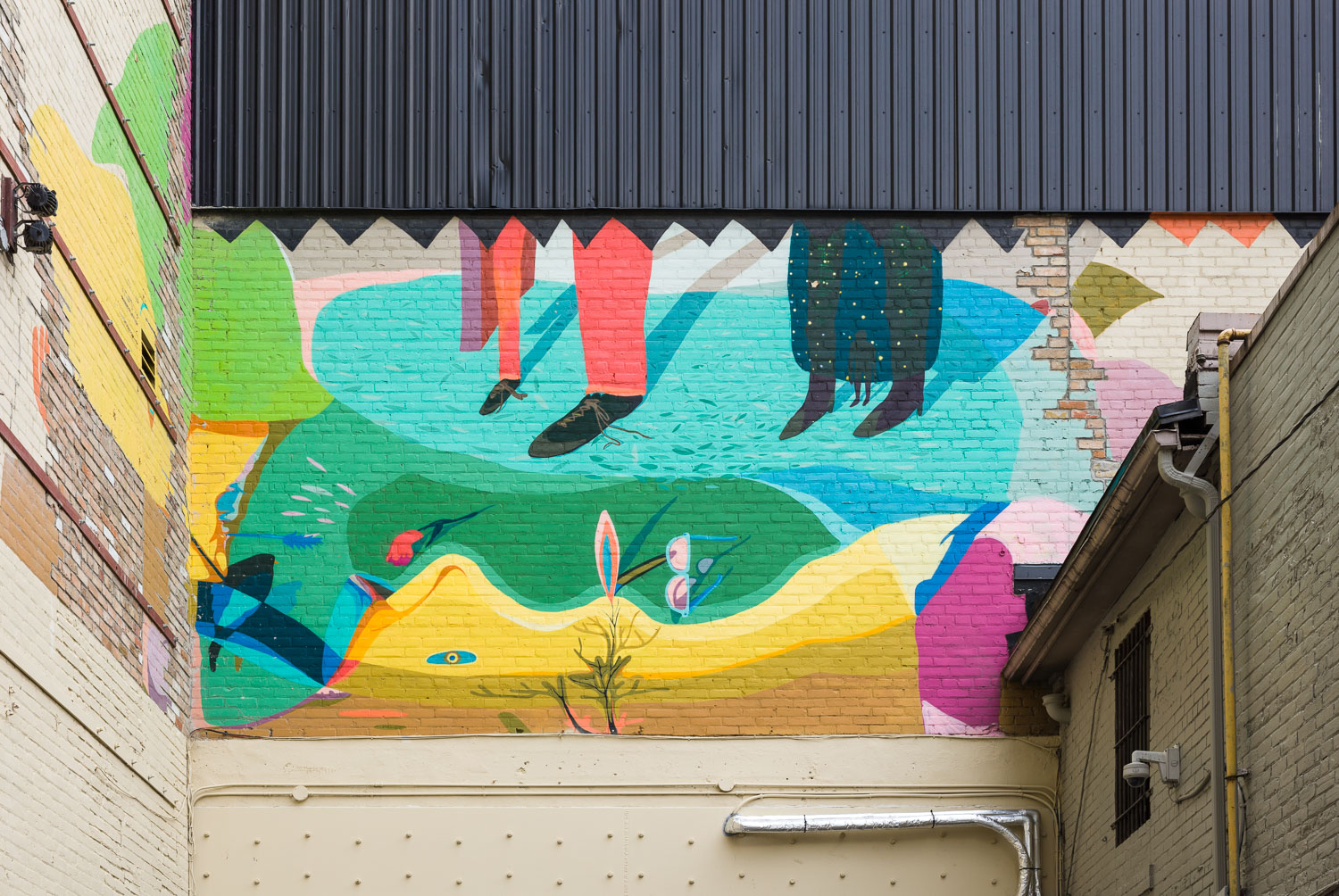
- Latex and spray paint
- 2014
- O’Keefe Lane South (Mirvish Theatre), Toronto
About the artwork
The mural, in collaboration with Downtown Yonge BIA, took inspiration from the Mirvish theatre setting, now stands as a vibrant icon and a catalyst, not only for a greater focus on laneway revitalization, but also for stronger community collaborations.
The abstract and colourful shapes invite the public to walk through the street and come to admire the hidden gems of Toronto’s urban realm. While visitors will mainly refer to the bright colours of the mural, the artwork also depicts different human shapes, yet not seeing their faces, perhaps a metaphor of our urban living.
About the artist
PA System’s Alexa Hatanaka and Patrick Thompson work in textile, printmaking, painting, video, and public art. They create collaborative and socially-engaged projects namely in the high arctic, including their ongoing project with Inuit youth in Kinngait (Cape Dorset, Nunavut) called Embassy of Imagination.
Their work has been exhibited in institutions worldwide, such as the Royal Ontario Museum, The Art Gallery of Ontario, Centre de Cultura Contemporània de Barcelona, University of New Mexico Art Gallery, Canada House in London and the Guanlan International Printmaking Base in China. In September of 2019 they exhibited their work in the inaugural Toronto Biennial of Art.
PA System has been involved in the Kinngait community for six years spending three months at a time activating their Embassy of Imagination workshops or projects with the youth. They lead out-of-community projects with smaller groups of youth annually. Their work as PA System is currently informed by the significant time spent in Kinngait, as documentation of moments, memories and the land, and reflects on how they may address issues or aspirations identified by the youth, with the youth.
They have partnered with the District Education Authority of Kinngait to launch PPStudio (printmaking program) and Land and Cultural Leadership Program. Equipment funding for the latter program is received from the sales of the collaborative Future Snowmachines in Kinngait ongoing project. The Snowmachines have been exhibited in the AGO and as a large-scale installation at The Bentway.
Fun facts
- Downtown Yonge neighbourhood has more than 1.5 km of laneways which presents a challenge for the area and its community to revitalize Toronto’s streets.
Engagement questions
- Do you think art walks can be great tools for engagement processes?
- Would you like to be involved in more community-led creative projects?
Polaris Music Prize x Haviah Mighty
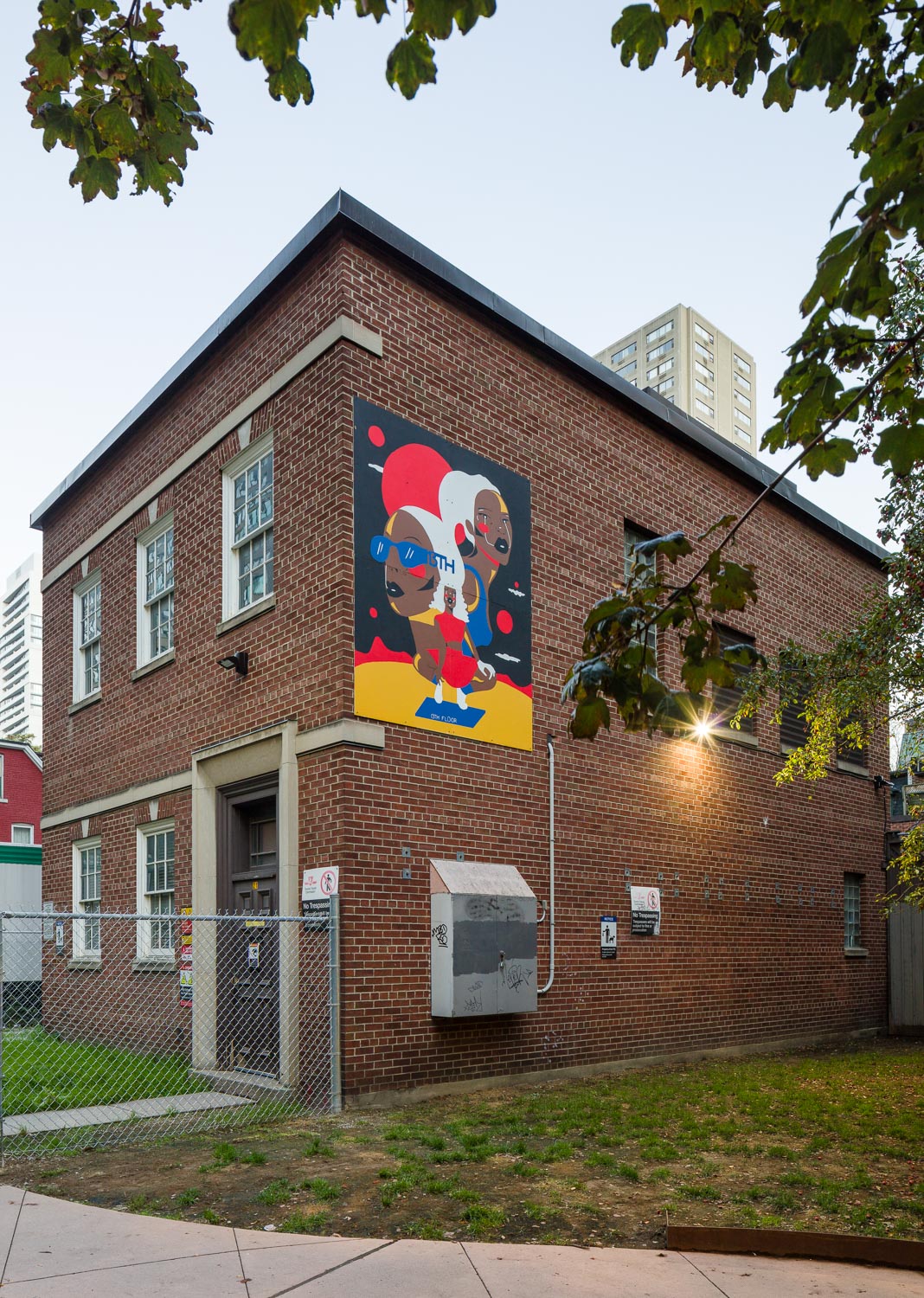
- Printed poster
- 2019
- 21 Granby Street (TTC McGill Granby Station)
About the artwork
This public artwork, in collaboration with Downtown Yonge BIA, is a giant mural version of the poster design made for Haviah Mighty’s album 13th Floor nominated for the 2019 Polaris Music Prize.
The same year, Haviah became the first Hip-Hop artist, as well as the first Black woman, to win the Polaris Music Prize for her album 13th Floor. The project highlights Haviah’s relentless work ethic and vast sonic influences.
About the artist
Alexis Eke is an illustrator and designer based in Toronto. Inspired by Renaissance portraits and traditional Japanese art, she illustrates Black women in a contemporary light. Her mission is to expand the representation of Black women in design and to evangelize, by creating a space for audiences to deeply reflect on themselves and their relationship with God.
With the foundation of a strong female Caribbean upbringing and relationship with God, she aims to use these important aspects to design a unique space for audiences to view her work. Growing up with women with strong personalities, she has always viewed women as resilient and independent. This has later been translated into her artwork, as all of her illustrations are of women, to reflect her cultural and personal experience.
Her clients include Adidas, the Art Gallery of Ontario, CBC, Globe and Mail, Nike Jordan, Palm BaySpritz, Polaris Music Prize––among others.
Fun facts
- The artist is often asked “What do the white lines in your work mean?” For Eke it is quite simple: The white lines connect from the eyes to the mouth to represent what we see and influence how we express ourselves and treat others.
Engagement questions
- What do you think of this artwork and would like to see more of the artist around your neighbourhood?
- Does this artwork make you curious about what it represents?
Hockey Knights in Canada, Les Rois de l’Arène
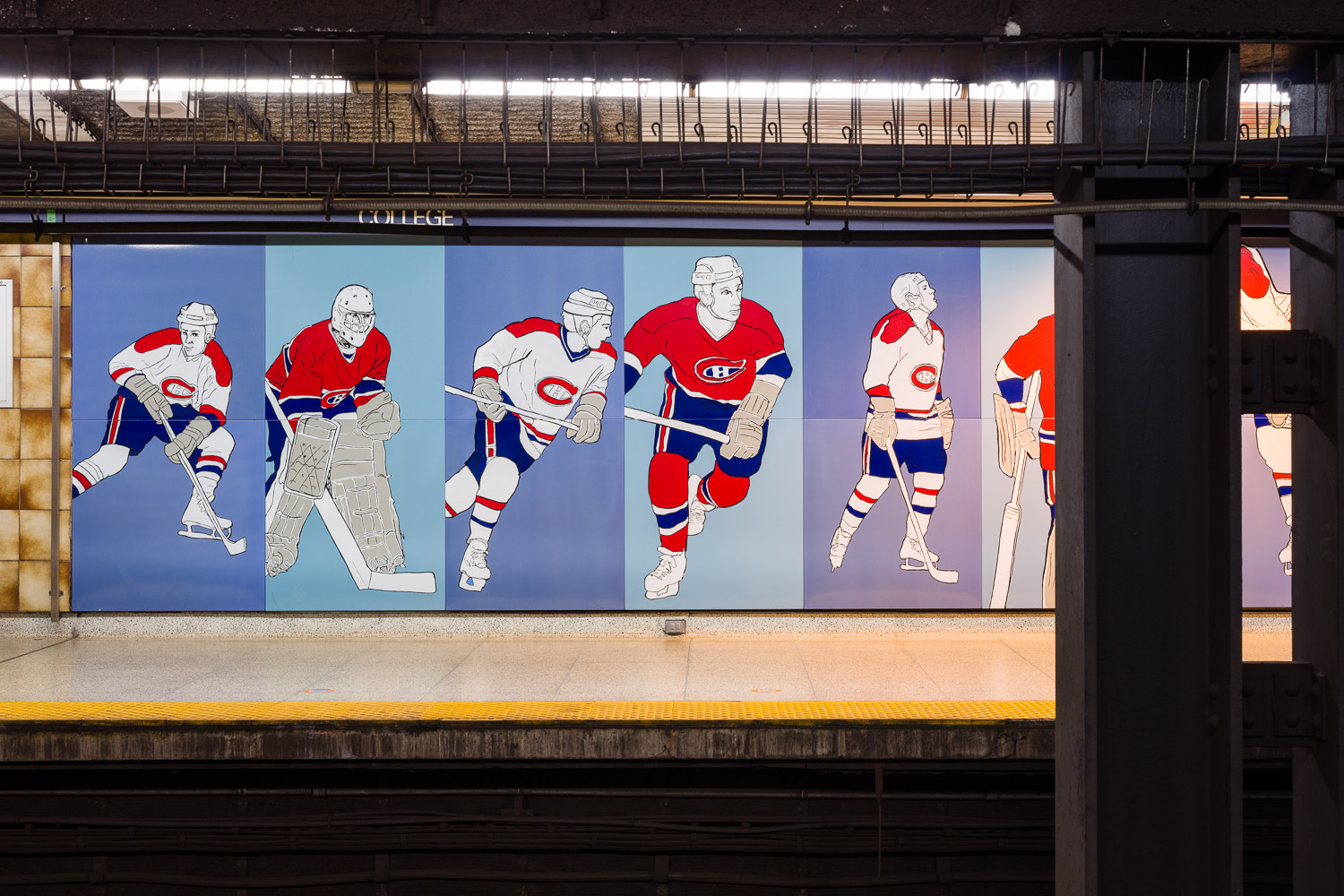
- Mural
- 1985
- College Subway Station, Toronto
About the artwork
While waiting for the next subway at Toronto’s College Station, riders see two platform walls facing each other. One depicts players of the city’s NHL hockey franchise, the Maple Leafs; the other shows their historic rivals, the Montreal Canadiens. This well-known mural, which depicted the Maple Leafs’ biggest rival, enraged team owner Harold Ballard at the time.
The piece, made by Canadian artist Charles Pachter and called Hockey Knights in Canada, Les Rois de l’Arène, appeared in 1985—much to the dismay of the owner of the Maple Leafs, who tried to have it taken down. As the CBC reported in 1984, Ballard was furious that the Toronto Transit Commission station feeding fans into his Maple Leaf Gardens would depict his team’s arch-enemy. He even threatened to pull permission to use the Maple Leafs logo on the piece. Pachter—no stranger to artistic controversy—saw Ballard as a bully, and the TTC backed him up, confirming that the piece would not be in violation of copyright law.
Pachter’s piece was installed towards the end of the 1984-85 season, one in which the Maple Leafs held the worst record in the NHL. Said the artist to the CBC at the time, “The Leafs being in the condition they’re in, it’s good press for him.” In 1999, the team moved a few stops down the TTC’s Line 1 to Air Canada Centre. But the art piece, Hockey Knights in Canada, Les Rois de l’Arène remains in its original place.
About the artist
Charles Pachter, born in Toronto, is a Canadian contemporary artist. A painter, printmaker, sculptor, designer, historian, and lecturer, he studied French literature at the Sorbonne, art history at the University of Toronto, and painting and graphics at the Cranbrook Academy of Art in Bloomfield Hills, Michigan.
His work has been shown at the Art Gallery of Ontario, the Royal Ontario Museum, and the McMichael Canadian Art Collection, Kleinburg. His mural, Hockey Knights in Canada, Les Rois de l’Arène, can be seen at Toronto’s College subway station, where the Montreal Canadiens face the Toronto Maple Leafs across the tracks. He holds honorary doctorates from Brock University, the Ontario College of Art & Design and the University of Toronto.
He was named a Member of the Order of Canada in 1999, and promoted to Officer in 2011. Pachter lives and works beside Grange Park in an award-winning residence and studio designed by Canadian architect Stephen Teeple. His work is on permanent display in his adjoining Moose Factory gallery. Pachter’s work has influenced a generation of young Canadian artists, including sculptor Harley Valentine.
Fun facts
- When Pachter decided to depict hockey players in the blue-and-white uniforms of the Leafs along one platform and on the opposing side: the bleu, blanc et rouge of the Montreal Canadiens, his piece caused some commotion. If the TTC insisted on including the Habs in the artwork, Leafs owner Harold Ballard threatened not to allow the Leafs' distinctive logo to be used. But the TTC's position was that it was not in violation of copyright laws.
Engagement questions
- How can we best ensure creativity towards personal considerations?
- Do you think copyright laws should be less restrictive for artists? Where are the boundaries for public art commissions?
Our Nell
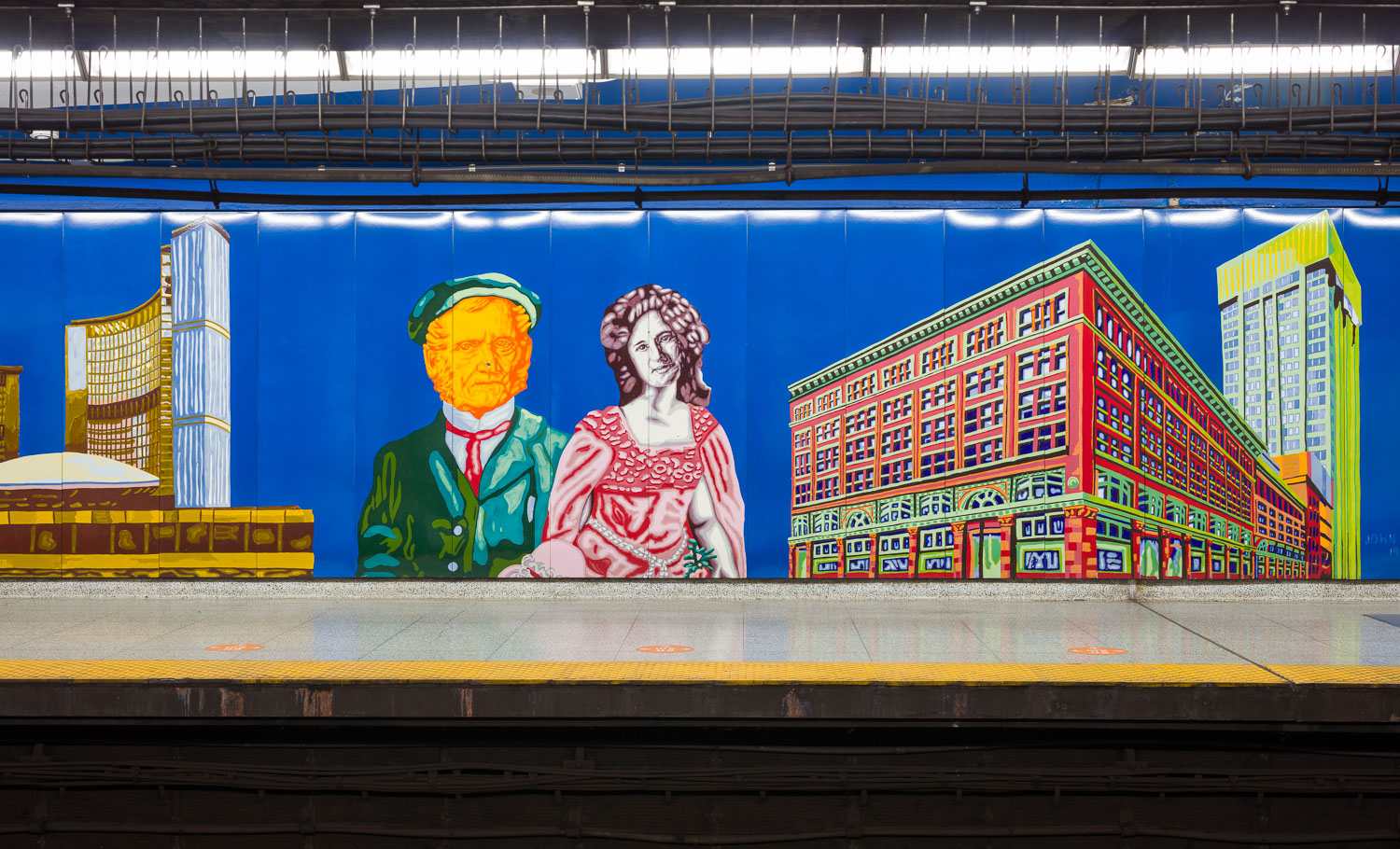
- Enamelled steel
- 1980
- Queen Station, Toronto
About the artwork
Queen Station contains a painted mural by self-taught Canadian John Boyle at the platform level titled Our Nell. Featuring depictions of Nellie McClung, William Lyon Mackenzie, as well as the former Simpson’s and Eaton’s department stores, Boyle’s work was known for his use of subjects drawn from his own specific life experience and from Canadian history. He was a part of the London Regional art movement.
Nellie McClung, women’s rights activist and one of the Valiant Five who successfully petitioned to have women recognized as “persons” by the Dominion government in 1927. The male figure is that of William Lyon Mackenzie, member of the Upper Canada Legislative Assembly 1827-1834; Toronto’s first lord mayor 1834; founder/publisher of the reform newspaper, The Colonial Advocate and leader, in Upper Canada of the Patriots’ Rebellion of 1837.
About the artist
John Boyle RCA is a self-taught award-winning Canadian painter, activist, curator and writer known for his use of subjects drawn from his own specific life experience and from Canadian history. He was a part of the London Regional art movement.
Boyle’s intricate and colourful paintings, dealing mainly with socio-political figures and elements of Canadian landscape, place him firmly within the realm of the Canadian response to the 1960s-era Pop phenomenon.
Boyle lived most of his life in the small town of London, Ontario. After studying at the London Teachers’ College and the University of Western Ontario, he moved to St. Catharine’s in 1962, where he worked intermittently as an elementary school teacher then, from 1968 on, as a professional artist. He also lived for a while in Elsinore, a small hamlet near Owen Sound and now resides in Peterborough.
Boyle initially intended to become a writer, but after seeing an exhibition of the work of Vincent Van Gogh in Detroit in 1962, he decided to concentrate on painting. Largely self-taught, he fully committed to his art, and his unique approach quickly began to garner interest. The artist is one of the few since the early twentieth century to focus on the Canadian socio-political figure outside of the realm of portraiture (Lakeside Park, 1970). Boyle is also noted for his emulation of the colour profile of screen-printing by omitting half-tones from his palette. This gives his paintings a dramatic intensity that reinforces the importance of the presented figures.
Boyle, deeply passionate about artist’s rights, spearheaded the foundation of the Niagara Artist’s Company in 1970 and was the founding spokesperson for CARO, the Canadian Artists’ Representation Ontario, the following year. The artist, whose paintings can be found in major collections across the country, was elected to the Royal Canadian Academy in 1975, received Canada Council B Grants in 1971, 1973 and 1979, and a Canada Council A Grant in 1987.
Fun facts
- People have often complained about the mural and in 2013 a woman named Frances Campbell advocated for its removal. And even though the mural looks like “potato-face people,” Frances should know the deeper meaning of this art piece. Indeed, the mural depicts Nellie McClung, a women’s rights activist and one of the Valiant Five who successfully petitioned to have women recognized as “persons” by the Dominion government in 1927.
Engagement questions
- Would you like as a citizen to be even more included within the community outreach and public engagement process in order to submit your personal thoughts over public art commissions?
- As long as art exists, it will always raise some approval as well as some disapproval: How can we deal with subversive concepts and ideas?
